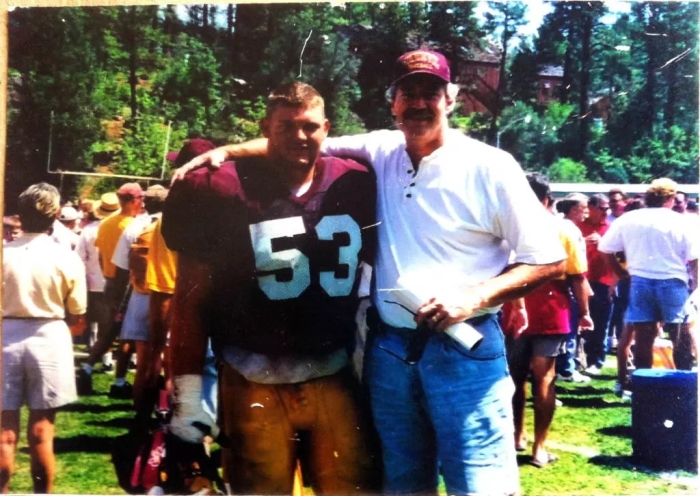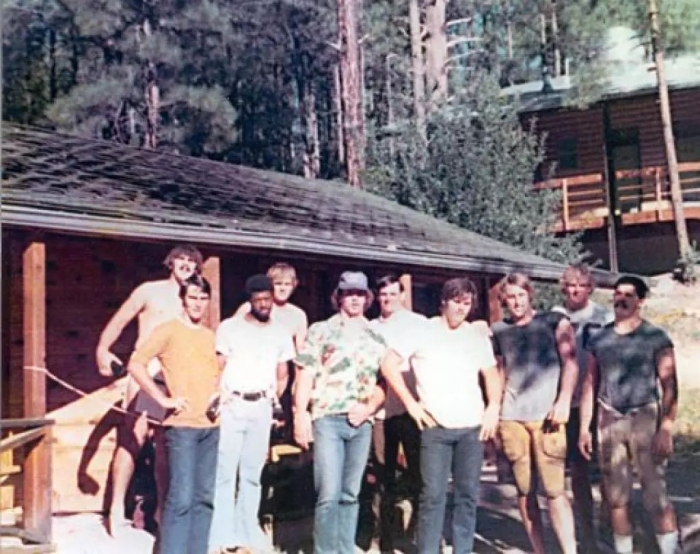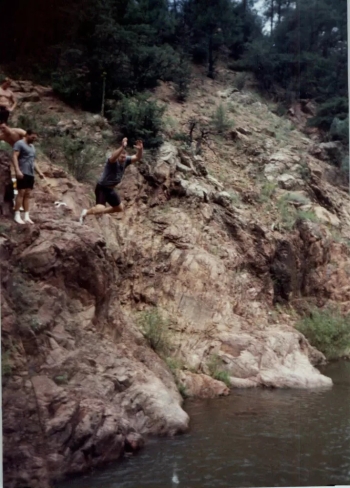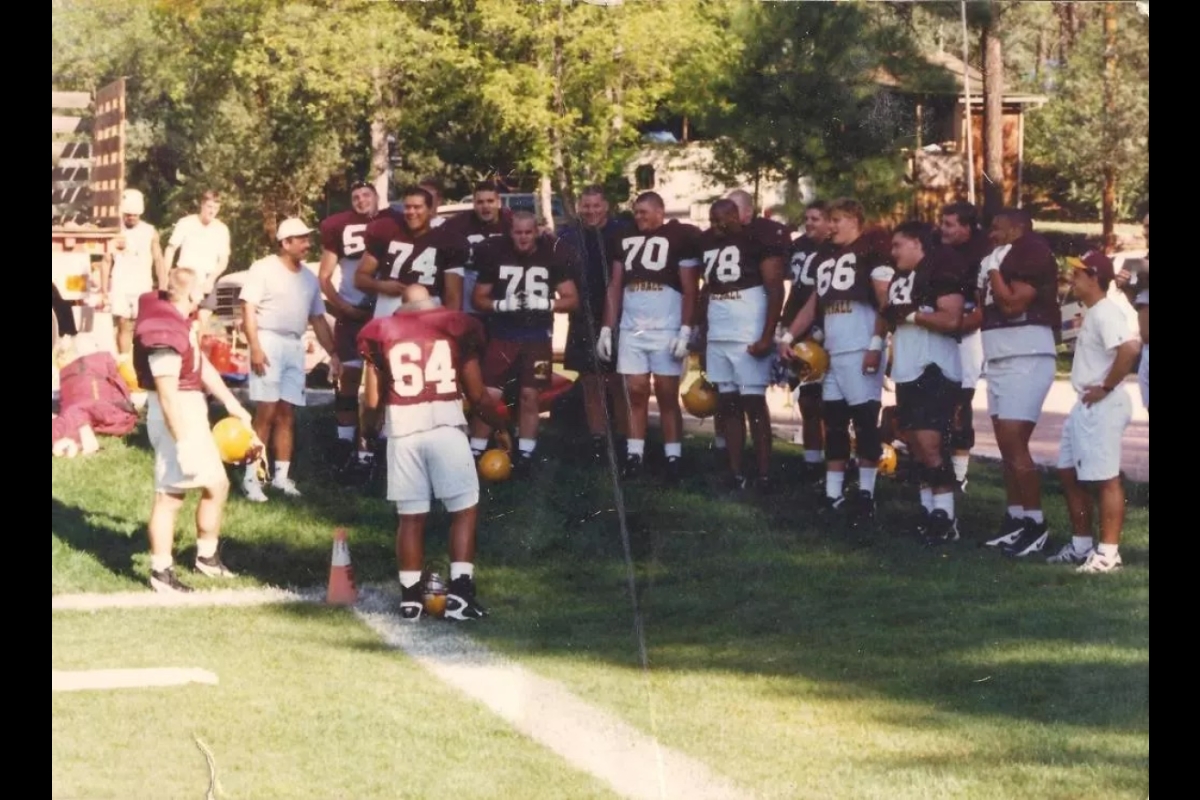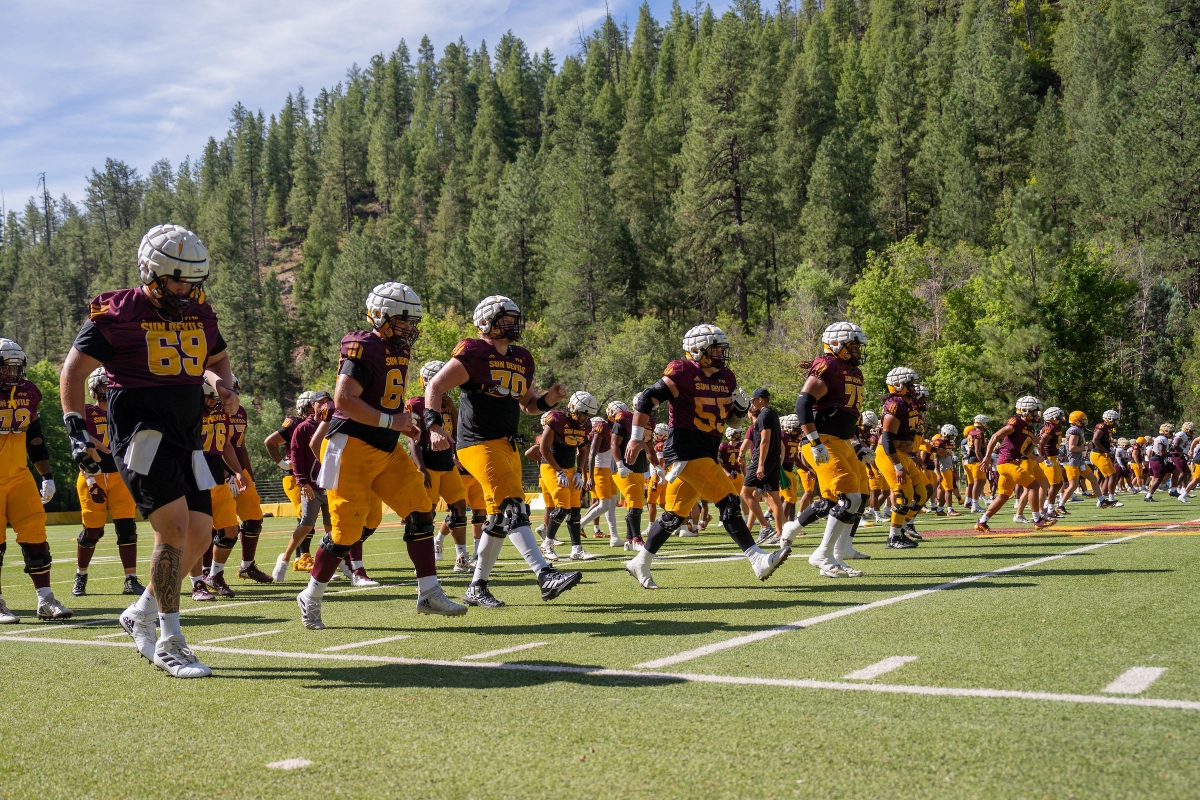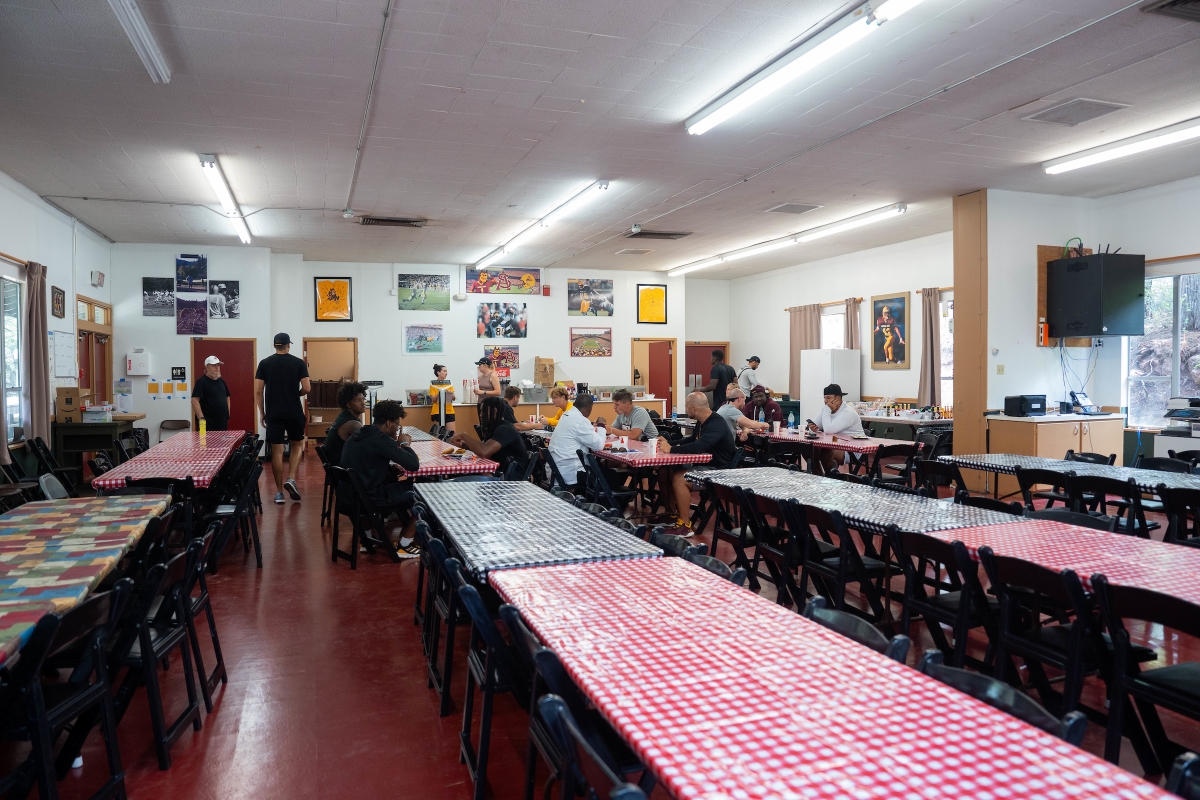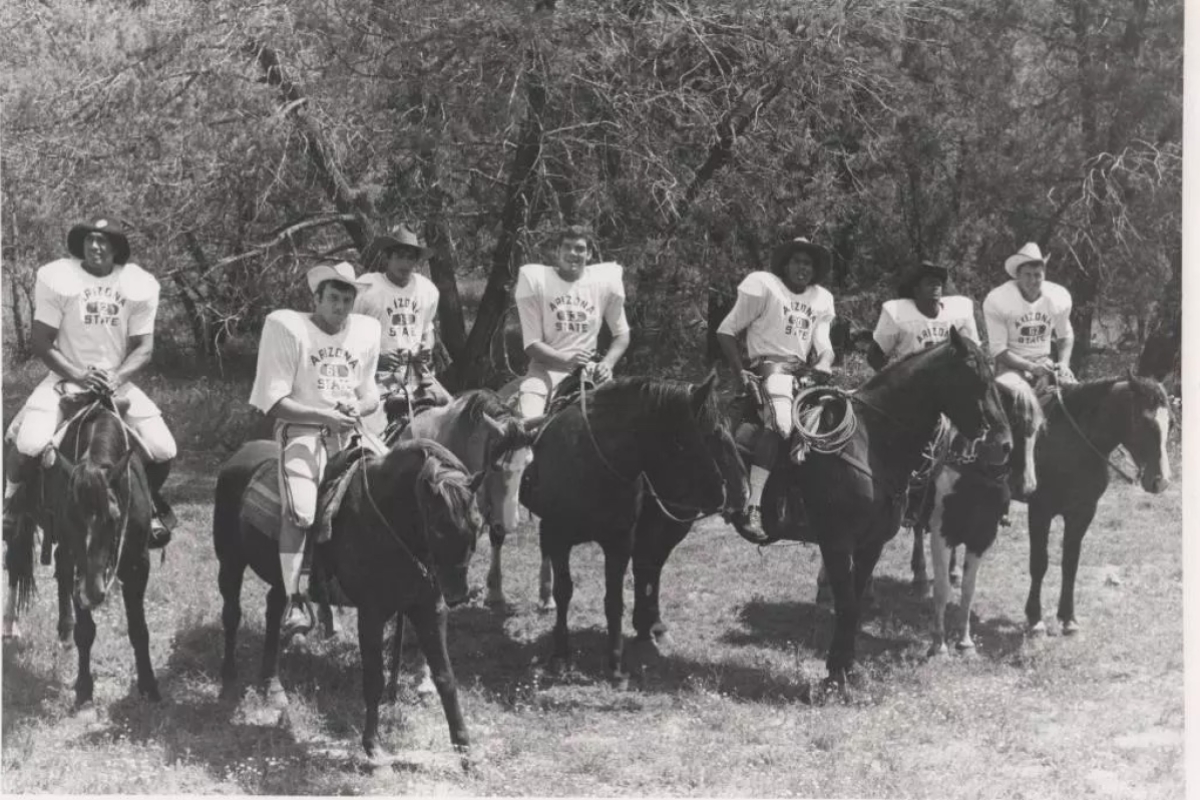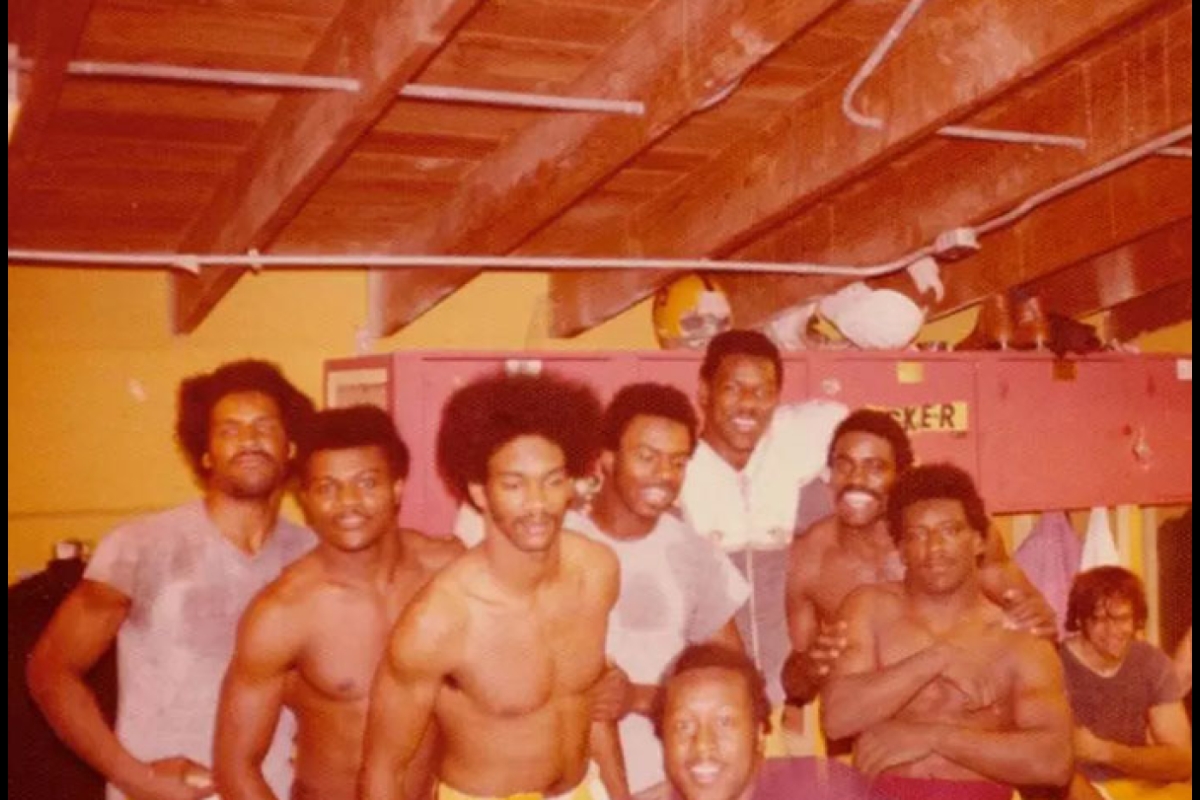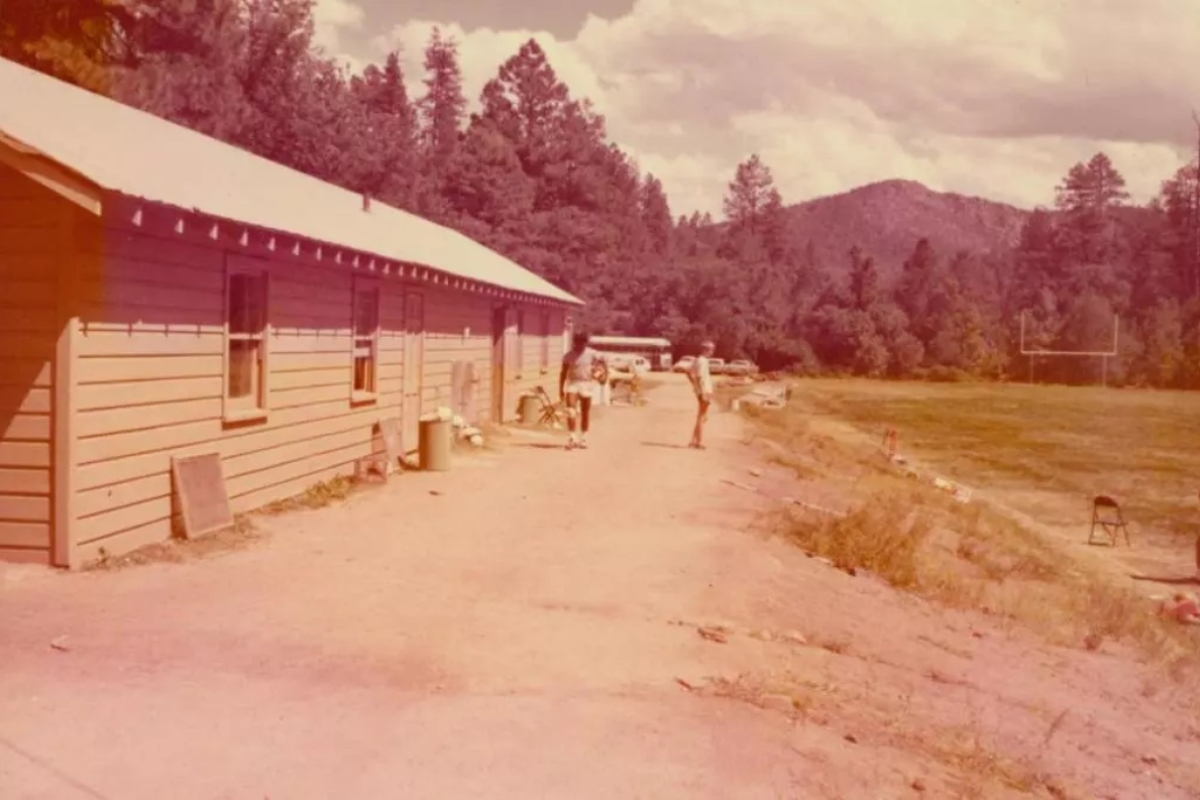Bonding, bunk beds and ... a dead bat? An oral history of Camp Tontozona
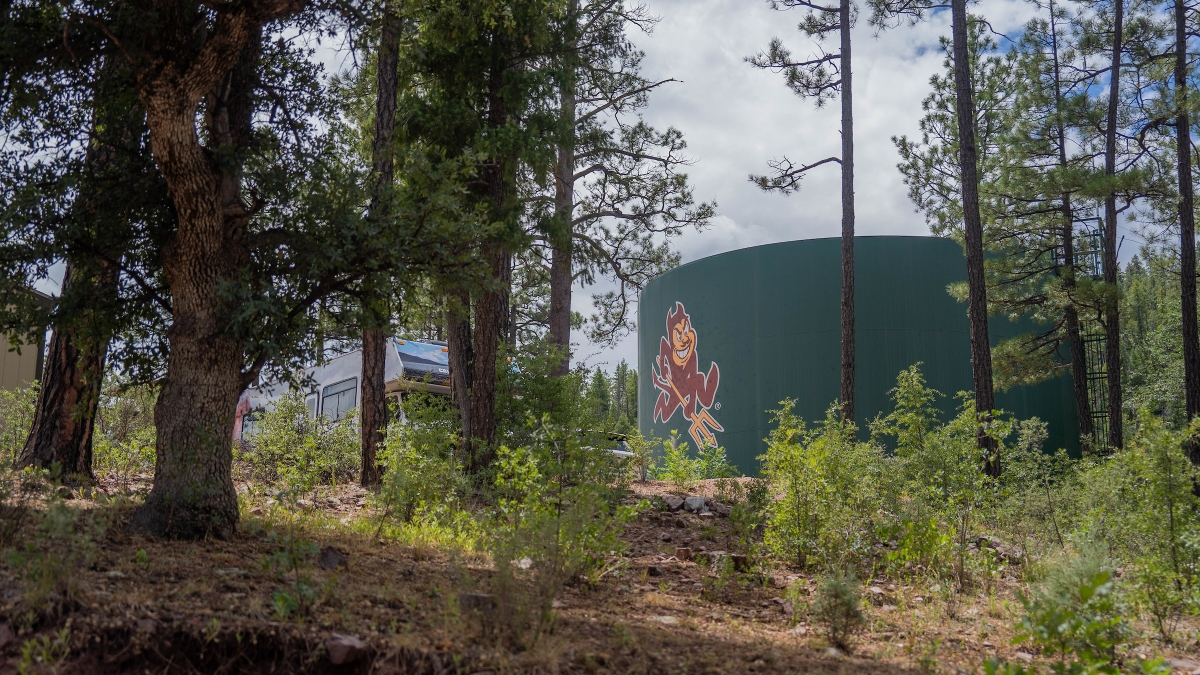
Sparky is displayed on a water tank at Camp Tontozona in Payson on Aug. 10, 2023. Photo by Samantha Chow/Arizona State University
Editor’s note: This story is featured in the 2024 year in review.
More than 60 years have passed since Arizona State University coaching legend Frank Kush took the Sun Devil football team to train at Camp Tontozona for the first time.
Since that 1960 excursion, college football’s landscape has changed dramatically. But Camp T, as it’s called, is a portrait of the past, etched among the ponderosa pines 17.9 miles outside of Payson.
With Coach Kenny Dillingham and the team spending three days at Tontozona Aug. 7–10, ASU News talked to 15 Sun Devils — players, coaches, trainers, administrators and more — to get a true sense of life at Camp T.
Getting there
Taking the right turn off Highway 260 and onto Camp Tontozona road is an eye-opener for players who have heard about the tradition but never experienced it for themselves.
Rudy Carpenter, quarterback, 2005–08: I kind of just had this idea that Arizona was all just cactus and desert, and then all of a sudden you kind of get halfway to Camp T and then it turns into basically what feels like a forest. I was just shocked that there was even that kind of landscape in Arizona. I had no idea where we were on a map.
Perry Edinger, ASU head trainer, 1989–2003: I remember saying, “Where are we and why is it raining so much?”
Kyle Murphy, offensive lineman, 1994–97: You’re really trying to process everything that’s going on. The freshmen had three days of practice (in the Valley) before the vets came in, so you start to feel comfortable. Then you get on a bus and you’re going to go up to Payson? Where the hell am I? Why are we doing that? Tradition? Because the temperature is lower? And then you’re like, “OK, where are we staying?" You keep walking and you go down to where the field is, and you see this piece-of-(expletive) freshman trailer.
C.J. Fite, defensive lineman: I was like, “This is going to be an experience.”
Into the woods
The beauty of Camp T is breathtaking. The field is rimmed by large pine trees and Tonto Creek. Mount Kush looms over the facility. A cold spring sits invitingly on one side of the field. The accommodations and working conditions, on the other hand, haven’t always been, well, luxurious.
Marcus Williams, senior associate athletic director; kicker 1994–97: Our trailer was pretty much military style. There were bunks everywhere. When you walked in, there was a couch in this little area to the left, but in every other room, there were just a whole bunch of bunk beds. People literally would be sleeping almost on top of each other.
Murphy: It was the worst place. You want to sleep but you’re on metal bunk beds, so when you move, they squeak. And they’re not firm. They sag. Was it the worst? No, but it was terrible.
Juan Roque, offensive lineman, 1992–96: You’re talking about maybe 30 guys in this trailer and, I’ll tell you, by day three it just wasn’t that pleasant. You had a lot of kids who probably were not the most hygienic at the time. The showers were at the end of the field in this little fenced area with a black tarp around it, but the water was ice cold. Guys would maybe take a five- or 10-second shower. Imagine three or four days of that. Even though it wasn’t 110 degrees, it was still in the 80s or 90s during the day. So it didn’t smell like a very nice place.
Scott Peters, offensive lineman, 1998–2001: I was on the floor. I went to the wrong cabin at first. It was for the second-year guys. They go, “Oh, that’s not for you. You’re over there in the trailer.” By the time I got there, all the beds were spoken for. So I found some disgusting mattress, put it on the floor and slept on it.
Mike Chismar, senior associate athletic director, operations and facilities: We used to have to go Payson every night to get our laundry done. And for a long time, we didn’t have cellphones. So one year, we had the vehicle break down on the way up the hill (back to Tontozona). And they had no way of communicating with us. They drew an arrow on the side of the road where the truck was. The DPS officer comes in — he usually would come in and watch practice a little bit — and he’s asking for me. I’m like, “How does he even know who I am?” So I went over to talk to him and he said, “Hey (the laundry guys) told me I need to reach out to you. Your truck broke down with the laundry in it." I said, “Oh my God.”
Kush's camp
The Sun Devils will practice once a day for three days and then have a scrimmage on Saturday. Things were a bit tougher at Camp T when Kush was the coach.
Danny Kush (son of Coach Kush), kicker, 1976: We’d have a full-pad scrimmage at, say, nine in the morning, and that would go until 10:30. Then you’d have a break for lunch. After that, you’d have passing game practice, where it was the quarterbacks, receivers, linebackers and defensive backs. The linemen would do linemen drills or weightlifting at the other part of the field. That was a 45-minute practice. Then you would get a little afternoon break before your third practice of the day, which again was in full pads, and you’d practice until 5:30 or so.
Danny White, quarterback, 1971–73: We’d be up there 10 to 14 days and have three practices a day. If you screwed up, he (Kush) made you go up Mount Kush after practice. If you screwed up again, he made your coach go up with you. That was pretty brutal. Usually, the coach would stop about halfway up when he was out of sight and make you run the rest of the way. If it was one guy doing all of that by himself, he’d say it was ridiculous. But since everybody was doing it, it turned into such a positive. It made us all tougher together.
Kush: It was very intense. A lot of guys didn’t make it. I’d say we probably lost a half a dozen kids who would get fed up and say, “OK, I’ve had enough. I need to get out of here.” Some of them would leave at night. Some would leave during the day, even in the middle of practice. They’d get up, get their stuff and walk out the gate. What they would do is walk to Kohl’s Ranch (a lodge 1.5 miles away) and call somebody to have them picked up, or they would just go get on the road and hitchhike. Guys would just hitchhike back to Payson, and then hitchhike from Payson back down to Tempe.
Team building
The days are long and the beds sag, but the hardships and lack of distractions — no social life, and cellphones rarely, if ever, work — make Tontozona the ideal place for a team to come together.
Todd Graham, coach, 2012–17: I’m a consultant for a Power Five school and somebody asked me, “Is there anything you see that we could do that we’re not doing?” I said, “Have a place like Camp Tontozona.” I’m telling you, having an opportunity to get away and team build … it’s the most productive thing we did.
Jake Plummer, quarterback, 1993–96: No girlfriends, no family, no apartments, no phones, nothing digital. Just us together. That was really the basis for us to be a unit. Even though a lot of the guys hated it because it meant two (practices a day), it was really special because we were together. We’d hang out in the cafeteria and have time afterwards to play dominoes and get to know one another better. I loved the experience.
Carpenter: A lot of time is spent when you’re not practicing. You’re in these small (cabins) and there’s a million beds, and you just end up talking to the guys that are next to you, finding out where everybody is from. Guys argue about who was better in high school and whose teams were better, whether Kobe (Bryant) was better than LeBron (James), just all of that stuff. Without the technology up there, you actually get a chance to find out who your teammates are. You get a chance to learn about them, who they are, why they are there, what they’re interested in, what they’re like. For me, that’s one of the big reasons I think Camp T is something they should do every year.
Roque: Those times at night were really precious. We’d get to know one another. We’d talk about life or politics or girls, or movies and books. It was just bonding, as brothers do.
Jim Jeffcoat, defensive lineman, 1980–82: When you finished Camp T, you felt like you had achieved something as a team before the season even started.
Fun and games
Of course, when 100 or so 18- to 22-year-olds are gathered at one place without a bunch of entertainment options, they’ll find a way to entertain themselves. At Tontozona, that has included skits, freshmen singing the ASU fight song, practical jokes and Pat Tillman taking up a challenge.
Williams: There are these huge black beetles up there. Guys would place a beetle on someone’s pillow, or they’d grab a twig or something and roll it up somebody’s leg during practice or a meeting to make it seem like a beetle was on them, and they’d absolutely freak out.
Carpenter: We’d make the guys who were really high recruits get up there and read their bios, like all the awards they won and how high of a recruit they were. We’d "ooh" and "aah" and kind of make fun of them. Or we would have talent shows, and you always had random guys that could really sing. I always told the guys that if you’re going to sing, sing the theme song from "The Fresh Prince of Bel-Air" (television show) because everybody knows that song. It’s easy to sing, so the rest of the team will start singing the song with you.
Roque: I have a little confession to make. There was a pay phone outside the chow hall that was disconnected, and we figured out how to rewire it so we could make collect calls to girlfriends or our family. After meetings were over and the coaches went to their cabins, we would go to the chow hall and make calls.
Murphy: Minus the trainers, you didn’t see any women for like 10 days. That’s a long time, man. Guys were going to figure out ways to call their girls.
Mark Brand, media relations, 1983–22: I remember this as if it were this morning. If you hike from the south end of the field, maybe three-fourths of a mile, you come to this waterfall with a huge ledge and at the bottom of it, there’s a hole that fills up with water. People were saying Pat Tillman was jumping off the ledge into the water, and nobody could believe it. Sure enough, he was doing it. It probably wasn’t the safest thing to be doing, but you know Pat. It was an adventure, and he was doing it.
Keith Poole, wide receiver, 1993–96: We all did that and had a blast, but no one went up as high as Pat. When I saw how high he was, I was like, “You’re just nuts.” He had to have some good aim to hit that tiny pool.
White: My uncle owned this bar in Christopher Creek (a small community 4.5 miles east of Tontozona), and I remember me and some teammates getting on the truck that was making deliveries and then just hanging out in the bar. The coaches were all going to Payson, and we went to Christopher Creek because we didn’t want to be around the coaches. Then we’d make it back to camp before curfew.
Plummer: One that sticks out to me is when (linebacker) Derek Smith did some deal at the end of his skit where he had a cup full of moths, he put them all in his mouth and then let them fly out. We were just freaking out.
Peters: The seniors would throw projectiles onto the roof of the freshman trailer at all hours of the night. You’d hear the tin roof getting blasted and hammered with whatever they were throwing. Then, one night, all of a sudden, it got quiet. We just figured they were done. Then — boom — they blast the door open and (defensive lineman) Jeremy Staat hits us with a fire extinguisher. The trailer was filled (with powder), so all of the freshmen ended up sleeping on the field.
Roque: There were so many pranks. The one that got us in trouble in 1996 was, well, Jake (Plummer) and I found a dead bat. I know there was a lot of hoo-ha in the media that it was alive, but it wasn’t. So we grabbed a pillowcase because we weren’t going to touch it if it had rabies. We got it into the pillowcase, and we walked into the freshman cabin and we’re just talking to all the guys, and after a couple of minutes, we said, “Hey, we brought something to you.” And we turned the pillowcase over and out flops the bat. Jake and I closed the door and the place went nuts. They were literally screaming. I think I even heard a window break because somebody was trying to get out. It got into the media’s hands and we got into a lot of trouble with an animal rights groups that thought we killed the bat, but it wasn’t alive. It was dead.
A tradition in the making
Kush couldn’t have known 64 years ago that he was creating an iconic portrait of ASU football. But that’s what Tontozona has become.
Brand: When the Pac-12 was formed and the Pac-12 Network came to be, they would go around to each campus to do preview shows, and the crew always fought to come to ASU because everybody wanted to go to Camp Tontozona. You didn’t have to invent sets or settings. Tontozona was beautiful. It was unique. All you had to do was show up and your show was going to be perfect.
Edinger: At night, you could hear the critters, whether it was a javelina or raccoons or every once in a while, you’d get rumors that a bear was out there. To me, that was really cool. It was just so peaceful. You never heard a car go by. How many times in your life are you outside and you don’t hear a car or see a plane go over your head?
Poole: It’s funny. We hated camp when we were there. We hated everything about it. The food, the cabins, the long days, everything. But once I went up there when my brother was playing a few years after me, and I thought, “What a setting for a college football camp. I don’t think anyone has anything like it.”
Chismar: Nobody else can say that they have this picturesque place that’s owned by the university that you go to for preseason camp. I remember Coach (John) Cooper coming to me between practices and saying, “Chis, take me up the hill. Let’s run up the hill.” I said, “Coach, we’re not running up the hill, but I’ll take you up there.” He loved it, and after the next practice, instead of running sprints, he took the team up the hill. That year (1986–87 season) we won the Rose Bowl, and the next year, ESPN was up there filming at the top of the mountain and the team sang the fight song. That was so neat. And nobody else has that.
Dillingham: I talk to the guys a lot about moments. I think that’s kind of what bonds people together. Camp Tontozona is just so unique. It’s a moment that they will remember forever.
Plummer: It’s a great tradition. I’m glad they brought it back.
More Sun Devil community

English grad perseveres in ‘unrelenting pursuit of story’
You can take the girl out of the South — but not for long.Mary Ryan Kirsch was born and raised in the Southern U.S. You might say that the particular ways of her home region — the unique flora and…

ASU grad tackles women's health disparities through honors research
Megha Pillai has had medical school on her mind since the start of her bachelor’s degree.The research and work experiences she’s had since then have only affirmed that medical school is right for her…

ASU Online graduate finds new purpose in public health
Samantha Krakar started her college journey with a bass in her hands and music in her heart — but life had a different rhythm in store.Originally a jazz studies major at a university in California,…


